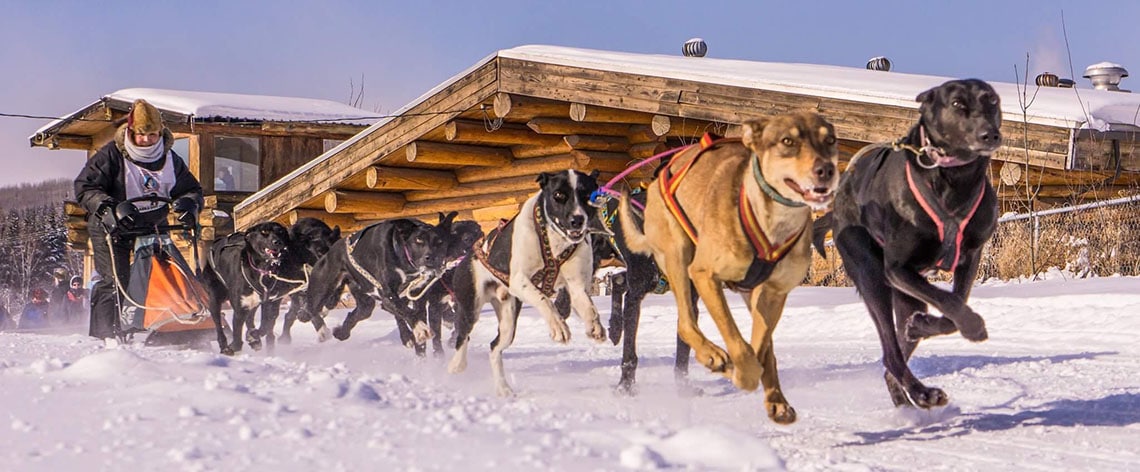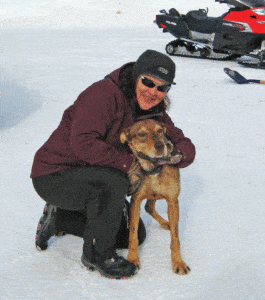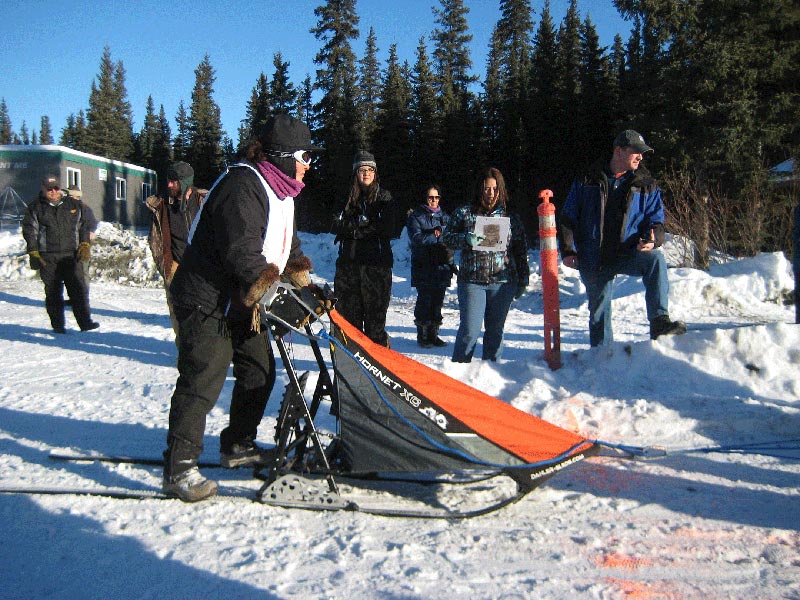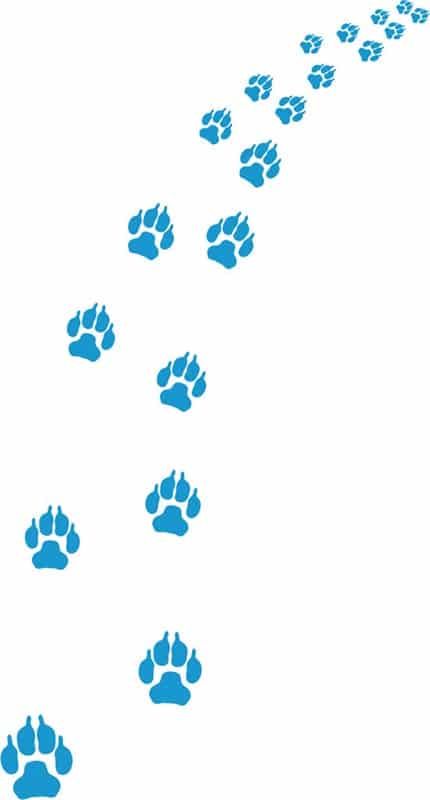Dog mushing has a long history in Alaska and the Ahtna way of life. Beginning in the 20th century, dog teams were used by the Ahtna people for transportation and packing goods, supplies and game meat.

Evelyn Beeter’s first memory of being in a dog sled is when she was four years old and with her family headed to check their Chistochina river trail trap line. It was her parents, Lena and Jerry Charley Sr., that later taught her how to mush. They also taught their children how to properly care for the dogs and cook for them using rice, kibble and dry fish. Evelyn and her siblings (Ernie Charley, Agnes Denny and Jerry Charley Jr.) also helped with hauling wood using the dogs and hooking them to the sled.
Evelyn started junior mushing when she was about eight years old. She remembers her mother taking all four children, plus their cousins, to the junior races in Tok. She continued to competitively race until 1976, her sophomore year at Glennallen High School, when she ran the 7-dog class in the Junior World Championship in Anchorage. Not only did she win, but she set a track record which was only just recently broken. She ended up taking a break from racing, but her love for working with dogs and the outdoors did not diminish and she knew she wanted to be involved in the sport again someday. She picked the sport back up in 1993 and started competitively racing again in 1996.

Evelyn credits her mother as being her original mentor and her inspiration to get into racing. Her mother ran sprint open races and did really well and later switched to distance mushing. She ran the Yukon Quest four times by the age of 58. When Evelyn started listening to the radio and hearing about dog mushing greats like George Attla, Dr. Roland Lombard and Roxy Wright, she was inspired to see their ability to compete no matter what their background or where they came from. Each of these racing inspirations had their own unique story. The late George Attla Jr. was a legend in sprint racing and one of Alaska’s most decorated mushers winning two premiere sprint races — the Fur Rendezvous World Championship Sled Dog Race in Anchorage and the Open North American Sled Dog Championships in Fairbanks — a combined total of 18 times. Dr. Roland Lombard was a veterinarian who was a famous dog racer in Alaska, even though he lived in Wayland, Massachusetts. Roxy Wright retired from competitive sled dog racing in 1996, but the Fairbanks native wrote the final chapter of her remarkable career when she captured her fourth GCI Open North American Championship in 2017 at the age of 66.
Evelyn describes her kennel of 18 dogs as being small. She only uses 8 of the dogs for racing; 3 retired dogs and 7 yearlings making up the rest of the pack. When it comes to traits she looks for in her dogs, she says they need to love running and have that drive to be a great sled dog. “A drive to want to work and please human beings, along with having a happy demeanor are important.”
Outlaw was the dog that Evelyn first started her team with. He was a husky breed and ran the Fur Rondy and the Yukon Quest races. Outlaw was very special to her and did what was asked of him in his 17 years, 15 of which he raced. Another favorite is the late Ruby. All of Evelyn’s current dogs are descendants from Ruby’s line. “She didn’t have the top-notch speed of other dogs, but she stayed in front of the dogs no matter what the pace was,” Evelyn said.

Although dog mushing is a winter sport, it takes year-round preparation to compete. Evelyn starts her training in the fall using a four-wheeler to get the dogs out three to four times per week. She incrementally moves their mileage up once they can run a route easily and then continues until there is enough snow to use a sled. Because she runs the 8-dog class she typically keeps her long run training sessions to under 13 miles. Her race season kicks off in January and picks up from February through March with races every weekend. The dogs are accustomed to traveling in the dog truck and get excited when they know it’s time to go race.
Evelyn sprint mushes which means her team is going very fast – up to 22 miles per hour – and she loves the rush of it. She is mentally tough and disciplined, but also truly enjoys what she does which gives her an advantage. Her career goal is to win the Limited North American 8-dog class; last year she placed second at the event in the 4-dog race. She recently won the Eagle River Classic 8-dog and Alaskan Sled Dog & Racing Association (ASDRA) Norma Rasmussen 8-dog in Anchorage. This year she was most looking forward to racing at the local Chistochina Fun Days which she serves on the planning committee for. She placed first in the 6-dog race and came in second in the 4-dog, but just by a hair.

When it comes to being prepared and safe on the trail Evelyn says she always has two snow hooks to hold the team and help stop. She also runs small teams using a snowmachine with a big string for her first run out to make sure there are no problems. She has had a couple run ins with moose on the trail, luckily without incident, so sometimes she has a snowmachine trail her which keeps the moose at bay.
Evelyn’s advice for youth that are interested in getting into dog mushing is to do it and enjoy it as it will teach you about yourself. A tip she offers is to get dogs from mushers that are already trained. “Don’t rush; take your time and figure out what type of mushing you enjoy – sprint, distance or just recreational.”
When it comes to her free time outside of mushing and work, Evelyn enjoys being social and building relationships with her grandchildren. She counts herself lucky to have her mother around to teach her and for her grandchildren to learn from.
“All I can say is that anything is possible, if you want to want to do it just go do it. That is how the people before us were. Thanks to my parents for raising and teaching us our ways of life.”
About Evelyn Beeter
Evelyn Beeter was born in Tanana, Alaska and grew up in Chistochina living the Ahtna way of life. She has one daughter, Marilynn, who also lives in Chistochina and three grandsons: Bjorn, Ronan and Finn. Her mother is Lena Charley and her father is Jerry Charley Sr. Her maternal grandparents are Jack and Daisy Nicolai and her paternal grandparents are Mary and Frank Charley. She belongs to the Atls’e’tnaey tribe and her father is of the Udzisyu clan.
Evelyn has worked at the Mount Sanford Tribal Consortium (MSTC) since 1993, currently as President, and before that the Copper River Native Association and as a Community Health Aid for Chistochina. In her role as President of MSTC she enjoys being in the community and working with partners to improve health care services in the region. MSTC is currently working on building a brand new clinic. Evelyn has spent most of her life in Chistochina with brief stints in North Dakota and Wyoming.
Banner photo courtesy Casey Thompson, inset photos courtesy Barbara Cellarius
